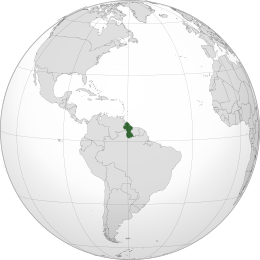共享资源:各地自治区法规/圭亚那
|
著作权法规: 圭亚那 快捷方式: COM:圭亚那 | |
 | |
 | |
| 保护期限 | |
|---|---|
| 标准 | 作者逝世+50年 |
| 照片 | 出版 + 50年 |
| 视听作品 | 出版 + 50年 |
| 死后出版 | 出版 + 50年 |
| 其他 | |
| 全景自由 | For buildings, sculpture and applied art |
| 截至年底 | 是 |
| 一般授权条款标签 | {{PD-Guyana}} |
| 协议 | |
| 伯尔尼公约 | 1994年10月25日 |
| 世界贸易组织成员 | 1995年1月1日 |
This page provides an overview of copyright rules of Guyana relevant to uploading works into Wikimedia Commons. Note that any work originating in Guyana must be in the public domain, or available under a free license, in both Guyana and the United States before it can be uploaded to Wikimedia Commons. If there is any doubt about the copyright status of a work from Guyana, refer to the relevant laws for clarification.
Background
Guyana was colonized by the Dutch, then came under British control in the late 18th century. It was governed as British Guiana until it gained independence as Guyana on 26 May 1966.
Guyana has been a member of the Berne Convention since 25 October 1994 and the World Trade Organization since 1 January 1995.[1]
As of 2018 the World Intellectual Property Organization (WIPO), an agency of the United Nations, listed the British Copyright Act 1956 (Cap. 74) as the main IP law enacted by the legislature.[1] WIPO holds the text of this act in their WIPO Lex database.[2] WIPO also lists the The Copyright (British Guiana) Order 1966 (Order No. 79 of 1966) (1966), which extends and modifies the 1956 act. WIPO holds the text of this order in their WIPO Lex database.[3] The changes in the 1966 order generally do not affect definitions of protected works or durations of protection.
General rules
Under the Copyright Act 1956, as modified by the order of 1966,
- Copyright in an original literary, dramatic or musical work shall continue to subsist until the end of the period of 50 years from the end of the calendar year in which the author died, and shall then expire.[74/1956 Section 2(3)]
- However, if before the death of the author none of the following acts had been done, (a) the publication of the work (b) the performance of the work in public (c) the offer for sale to the public of records of the work and (d) the broadcasting of the work, the copyright shall continue to subsist until the end of the period of 50 years from the end of the calendar year which includes the earliest occasion on which one of those acts is done.[74/1956 Section 2(3)]
- Artistic works include paintings, sculptures, drawings, engravings and photographs; works of architecture, being either buildings or models for buildings; and works of artistic craftsmanship.[74/1956 Section 3(1)]
- Copyright in artistic works generally subsists until the end of the period of 50 years from the end of the calendar year in which the author died.[74/1956 Section 3(4)]
- Copyright in an engraving that was not published before the death of the author subsists until the end of the period of 50 years from the end of the calendar year in which it was first published.[74/1956 Section 3(4a)]
- Copyright in a photograph continues to subsist until the end of the period of 50 years from the end of the calendar year in which the photograph is first published.[74/1956 Section 3(4b)]
- Copyright shall subsist in a sound recording until the end of the period of 50 years from the end of the calendar year in which the recording is first published, and shall then expire.[74/1956 Section 12(3)]
- Copyright in a cinematograph film shall continue to subsist until the film is published and thereafter until the end of the period of 50 years from the end of the calendar year which includes the date of its first publication.[79/1966 Section 13(3)]
全景自由
参见:共享资源:全景自由
![]() 可以 for buildings, sculpture and applied art, not for paintings, drawings, engravings or photographs.
可以 for buildings, sculpture and applied art, not for paintings, drawings, engravings or photographs.
- The copyright of a sculpture or work of artistic craftsmanship other than a painting, drawing, engraving or photograph which is permanently situated in a public place, or in premises open to the public, is not infringed by the making of a painting, drawing, engraving or photograph of the work, or the inclusion of the work in a cinematograph film or in a television broadcast.[74/1956 Section 9(3)]
- The copyright in a work of architecture is not infringed by the making of a painting, drawing, engraving or photograph of the work, or the inclusion of the work in a cinematograph film or in a television broadcast.[74/1956 Section 9(4)]
- Without prejudice to the two last preceding subsections, the copyright in an artistic work is not infringed by the inclusion of the work in a cinematograph film or in a television broadcast, if its inclusion therein is only by way of background or is otherwise only incidental to the principal matters represented in the film or broadcast.[74/1956 Section 9(5)]
引用
- ↑ a b Guyana Copyright and Related Rights (Neighboring Rights). WIPO: World Intellectual Property Organization (2018). Retrieved on 2018-11-05.
- ↑ Copyright Act 1956 (Cap. 74). Guyana (1956). Retrieved on 2018-11-05.
- ↑ The Copyright (British Guiana) Order 1966 (Order No. 79 of 1966) (1966). Retrieved on 2018-12-12.